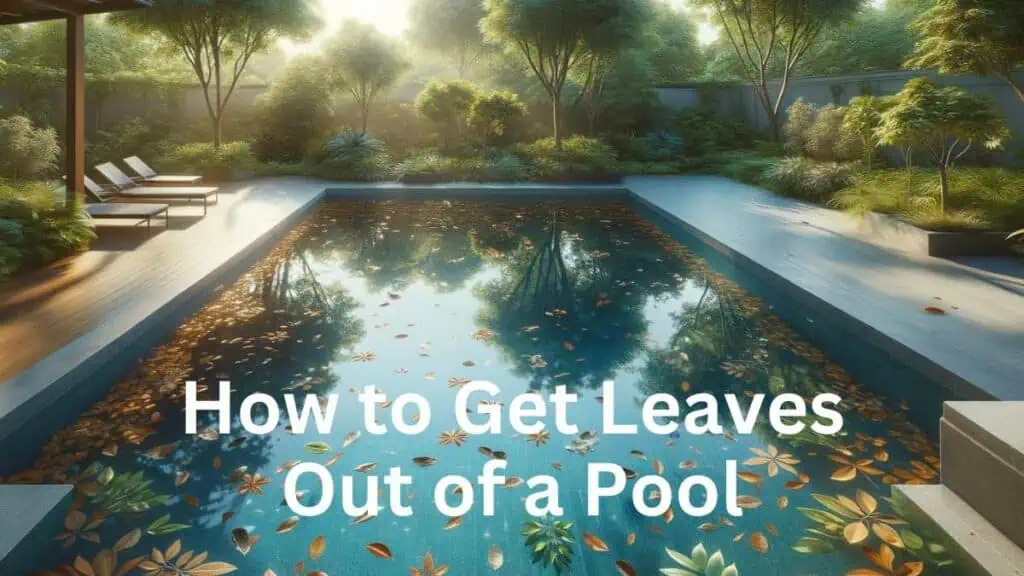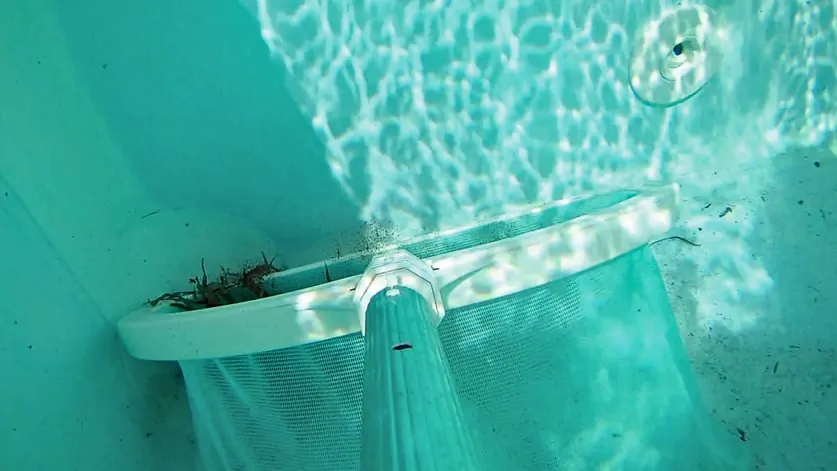Leaves in your pool are more than just an eyesore; they can clog filters, disrupt water flow, and even affect the chemical balance of your pool, making it a breeding ground for algae and bacteria. But with the right strategies, you can keep your pool as inviting as a cool breeze on a hot day.
The first line of defense is a good offense.
- Consider landscaping choices that minimize leaf litter, such as selecting pool-friendly plants or creating a strategic barrier with hedges or fencing.
- Regular skimming is a must for the leaves that do manage to make their way into your pool. A simple hand skimmer can quickly work on floating debris.
- For those who prefer a more automated approach, an automatic pool cleaner or a leaf-catching pool cover might be the best choice.
But what about the stubborn leaves that sink to the bottom? A pool vacuum or robotic cleaner can roam the depths, ensuring your pool floor remains spotless. For the occasional stragglers, a leaf rake with a deep net can scoop them up with little effort.
Combining these techniques lets you enjoy a leaf-free pool ready for a refreshing dip at any moment. So roll up your sleeves and prepare to reclaim your pool from the clutches of fallen foliage. With a little effort, your pool will remain the crown jewel of your backyard oasis.


Is it necessary to remove leaves from your pool?
Removing leaves from your pool is essential.
Leaves are not just unsightly and a nuisance for swimmers; they also contribute to algae proliferation. Organic compounds within leaves, such as phosphorus, can serve as nutrients for algae, encouraging its growth.
Beyond the risk of algae, there are other reasons to keep your pool leaf-free. Algae overgrowth can lead to discolored water, and the bacteria that thrive on algae can cause skin irritations or infections.
However, a handful of leaves floating in your pool isn’t cause for immediate concern. The real issue is the duration the leaves are left in the water and the quantity you’re dealing with. When leaves sink and settle on the pool floor and remain there, they can stain the pool’s lining or surface.
Leaves can also create problems for your pool’s filtration system. They have the potential to clog filters, reducing their efficiency and shortening their operational life.
Keeping Your Pool Leaf Free
Keeping your pool free of leaves requires a three-pronged attack.
1. How to keep leaves out of pool
Prevention is better than cure, so in an ideal world, you should try and stop leaves from getting into your pool in the first place.
This can involve strategic landscaping, such as planting lower-shedding plants or installing barriers like hedges or decorative fencing to block wind-blown leaves from reaching the water.
If you have trees around your pool, then they are likely to be a major problem. You could consider removing some of them, which is a shame as there are too few trees in the world. Of course, they could be next to your pool in a neighbor’s yard, so you probably can’t do anything about it.
Additionally, positioning pool equipment and accessories, such as slides or loungers, so that they don’t act as a funnel for leaves can also help reduce the amount that enters the pool.
Physical barriers for your pool are another great option:
Pool nets
Perhaps the best way to keep leaves out of the pool is to use a leaf net. This lightweight mesh can be placed over the pool surface, catching leaves while they’re still easy to remove. Once the bulk of the leaf fall is complete, the net can be removed, leaving you with a much cleaner pool.
If you use a leaf net cover, it will keep out leaves and other larger debris but won’t keep out dust and other micro-particles. The nets are stretched across the entire pool and will normally overlap by a few feet. They can be used at any time of year, but you would tend to use them only in fall and winter.
The Blue Wave Rectangular Leaf Net Pool Cover is a popular net pool cover. It comes in sizes from 12 x 20 feet to 30 x 50 feet, so there should be one to fit all pools.
If you can’t anchor it around the swimming pool, you can also buy Blue Wave water-filled tubes to hold it down.
Pool covers
A pool cover is mainly used in winter to stop debris from getting in. As they are a solid weave, they prevent debris from entering. They are somewhat like a tarp. These are NOT pool safety covers, which are much more expensive. You can find pool safety covers here.
Blue Wave also makes a good range of inexpensive winter pool covers in an even larger size range than their nets above. A winter cover will let rainwater pass through and very fine silt but stop anything else.
See the full range of Blue Wave Rugged Mesh Pool Winter Covers.
2. Stopping leaves sinking to the bottom
Regular maintenance is key in the battle against leaves.
Before you even start skimming leaves from the surface, the most sensible thing to do is to sweep any leaves around the pool, on the deck or paving, to prevent them from being blown into the pool.
Daily use of a hand skimmer net can swiftly remove leaves that have landed in your pool before they become waterlogged and sink to the bottom, where they are a bigger problem.
It will take a only few minutes each time but may save you much more time in the long run after they have sunk to the bottom of your pool.
If you do not already have a pool skimmer net then the heavy-duty one below from U.S. Pool Supply is very popular and available on Amazon.
Additionally, ensuring that your skimmer baskets are clear and your pool’s circulation system is working efficiently will help prevent leaves from settling and potentially causing blockages.
Tip to prevent leaves dropping to the bottom
At the time of year when I get most leaves falling in my pool I set my pump timer to run the pump for an hour a couple of times overnight. This way the skimmers pull in most leaves before they become waterlogged and drop to the bottom.
3. How to get leaves off bottom of pool
Removing leaves from the bottom of a pool is a common maintenance task that, while sometimes tedious, is essential for a clean and functioning swimming environment.
When leaves settle on the pool floor, they not only detract from the pool’s appearance but can also lead to staining, clog your filtration system, and disrupt the water’s chemical balance.
Pool leaf rake

The first step in removing leaves from a pool’s bottom is using a leaf rake or skimmer. These tools are designed with deep nets to capture large amounts of leaves and debris.
To effectively use a leaf rake, gently glide it along the bottom of the pool allowing you to slide the front of the net under the leaves and collect them. Without this, a net will probably just push the leaves around without picking them up. This method is particularly useful for larger leaves and heavier debris that may have sunk to the depths of your pool.
I use the Heavy Duty Leaf Rake above (available on Amazon) which works well.
Once you have removed as many leaves as you can with a leaf rake and allowed any fine debris to settle on the bottom of the pool again, you can vacuum your pool. Read: How to vacuum a pool.
If you have lots of leaves and other debris in your pool, the best thing might be to just bite the bullet after using the leaf rake and vacuum to waste. This is what I usually do for the first clean in the spring.
Vacuum the leaves manually
Some vacuum heads are better at dealing with leaves at the bottom of the pool than others. There are also other easy ways of removing leaves, which I will discuss further.
In my experience, the types of pool vacuum heads that have brushes underneath do not do such a good job as the brushes tend to push the leaves along without allowing them to enter under the vacuum head (and get sucked up). When I use this type of vacuum head to collect leaves I have to continually lift or tilt the vacuum head a little to allow the leaves to be drawn in underneath.
The best multipurpose vacuum heads for vacuuming leaves from a pool are those without brushes and which have wheels that keep the head just off the pool bottom. Leaves can pass under this type of vacuum head more easily and be sucked up into the pool hose.
I use the FibroPool Professional-Grade Flexible Pool Vacuum Head above (available on Amazon) which I find works well for removing the leaves left after I have used a net to remove the bulk of them. The wheels stop the head from scratching the pool surface too and it is also weighted to help keep it on the bottom of the pool.
The added advantage is that the head is flexible so it vacuums the joint between the floor and the wall easily.
Other ways to get leaves off bottom of pool
Leaf gulpers
There are also some specialist leaf vacuums, also known as leaf gulpers, leaf masters or leaf eaters. These have a net that collects the leaves as you move them around the bottom of the pool. These are great if you want to know how to get leaves out of the pool without a vacuum.
They connect to a standard garden hose, not to a pool vacuum hose, and the water flow powers it. The most popular of these is the U.S. Pool Supply Professional Swimming Pool Leaf Terminator Vacuum which has eight water nozzles to create a current and push the leaves into the net – a very clever design.
In-line leaf strainers
These are devices that you connect to your vacuum hose which strain the leaves before they enter the pool pump and filter system and trap them in the leaf canister. They can be used with both manual pool vacuums and automatic pool cleaners.
There are a few different models on the market. One of the most popular is the Hayward W560 PoolVac Navigator.
It attaches to standard 1.5″ pool vacuum hoses and is easy to empty the collected leaves. You can also fit a pool skimmer sock to trap smaller debris particles.
There is also another type of leaf strainer that uses cyclonic technology to separate the leaves when they are sucked up. This means it doesn’t become clogged and lose suction like some other types of inline leaf strainer can.
The Zodiac Cyclonic Leaf Canister fits all types of vacuum hoses as it comes with various adapters to suit most setups. It has a side handle to make emptying the leaves and other debris easier.
The ultimate in leaf removal – a robotic pool cleaner
If you can afford one of these, it will certainly be something you will never regret. A robotic pool cleaner will happily work its way around the bottom of your pool and up the sides, removing leaves and dirt as it goes. What can be better than that?
I finally bought a Dolphin robotic pool cleaner almost 2 years ago and I must say it is the best investment I ever made as far as our pool is concerned. How did I ever survive without it? It saves me hours of work each week and as it is so easy to use I clean more frequently too
I also have several friends and neighbors who own them and they say they wouldn’t want to be without theirs either.
The overwhelming consensus on the swimming pool cleaning forums and Facebook groups is that the Dolphin Nautilus CC Plus robotic pool cleaner is the best on the market, by far, yet it is nowhere near the most expensive available.
The Nautilus does not use the pool’s filter system so does not need to be connected to a vacuum hose. Instead, it is powered via an electrical cable and moves around the pool, including climbing the walls, cleaning and scrubbing the water line as it goes.
It collects leaves and debris and holds them within its filter. It is programmable to run at set times of the day or week.
Frequently asked questions
Can you shock a pool with leaves in it?
You can still shock a pool with leaves in it, but the process will be less effective. The chlorine will attack the leaves and any other organic material, so it will be used up rapidly. It would be better to remove the leaves first unless we are just talking about a few, in which case they will not have much of an adverse effect.
Can leaves stain a pool?
Yes, leaves can stain the bottom of your pool as many contain various oils, such as tannin. Fortunately, most of these stains may fade away due to the action of the chemicals over a few weeks without you having to take any action to remove them.
How do I keep leaves out of my pool?
You can ensure your pool skimmer is working efficiently so that leaves will be trapped in it before they have a chance to sink to the bottom of the pool. During the fall it may be worth covering your pool when not in use to prevent large amounts of leaves from entering.














Leave a Reply